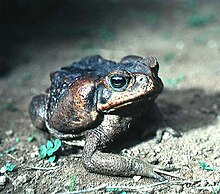
The cane toad (Bufo marinus) is also known as the marine toad or the giant neotropical toad. It is native to Central and South America and has been introduced to Australia and the Caribbean islands.
They have poison glands and the tadpoles can be very dangerous if digested. Since it has a devouring appetite, it has been introduced to Australia and the Caribbean for a method in agriculture to control pests. The cane toad
gets its name from the cane beetle which it is used against. Now, the cane toad itself is considered as a pest and many species of reptiles in Australia, like the monitors, are going to be classified as a threatened species as they eat this toad. When they eat this toad, they die as the cane toad secrets poison from its glands.
Physical Features Female cane toad
 Cane toads are the largest toads, especially females, who are longer than males. Females grow 10 to 15 inches long. They live for about 15 years in the wild whereas in captivity, they are few specimens which survived till the age of 35. The biggest cane toad is a pet in Sweden named Prinsen who weighs about 2 kg and measured 38 cm snout to vent. When it is fully extended, it reaches a length of 54 cm.
Cane toads are the largest toads, especially females, who are longer than males. Females grow 10 to 15 inches long. They live for about 15 years in the wild whereas in captivity, they are few specimens which survived till the age of 35. The biggest cane toad is a pet in Sweden named Prinsen who weighs about 2 kg and measured 38 cm snout to vent. When it is fully extended, it reaches a length of 54 cm.Cane toads have warty and dry skin. They have big paratoid glands under each eye.
Juvenile cane toads are much smaller than adult cane toads at 5 to 10 cm. Some juveniles have a red wash while most of them have smooth dark skin. They do not have fully developed paratoid glands and therefore are not as poisonous as adults.
Diet
Cane toads track down their prey using the sense of smell and vision. They normally feed on invertebrates, birds, reptiles, rodents and other amphibians. They also eat dog food if they are kept as a pet. They eat their prey by swallowing it whole.
Defense Paratoid are below the eyes
 The cane toad has paratoid glands below their eyes and across their back which secrete a toxin called bufotoxin. When threatened, they will secrete this toxin which is like a milky white fluid. Many animals die when they eat this toads and even some humans have died.
The cane toad has paratoid glands below their eyes and across their back which secrete a toxin called bufotoxin. When threatened, they will secrete this toxin which is like a milky white fluid. Many animals die when they eat this toads and even some humans have died.Cane toads are even capable of inflating their lungs, puff up and raise there body to look more taller and bigger when they face more dangerous predators.
Distribution
Cane toads are native to the Americas. It was introduced to South America and Australia. It lives in semi-arid areas and tropic environment.
Predators
The cane toads have many predators in its native range. They are: the banded cat eyed snake, broad snouted caiman, eels, species of killfish, rock flagtail, some species of catfish and different species of ibis. The predators outside its native range include the whistling kite, rakali, the black rat and monitors.
Source of picture 1: http://www.zimbio.com/pictures/oM3V0WcqZFd/Townsville+Hosts+Cane+Toad+Collection+Day
Source of picture 2:http://larrybiggs.net/scwf/index.php?mod=103&action=0&id=1195616778
Source of picture 3:http://en.wikipedia.org/wiki/Cane_toad
No comments:
Post a Comment